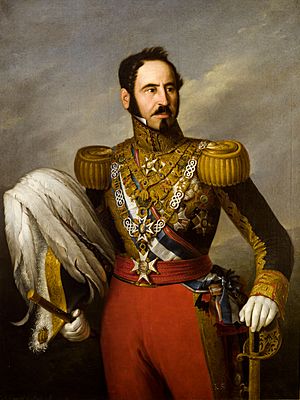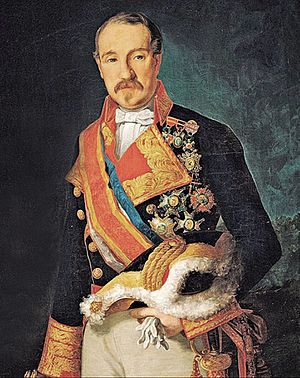Spanish Revolution of 1854 facts for kids

The Spanish Revolution of 1854 was an important event in Spain's history. It is also known as the Vicalvarada. It began when rebel soldiers, led by General Leopoldo O'Donnell, 1st Duke of Tetuan, clashed with government troops. This happened near a village called Vicálvaro.
This clash led to a military coup and a big uprising by the people. These events took place between June 28 and July 28, 1854. This was during the time when Isabella II of Spain was Queen.
The Spanish Revolution of 1854 brought an end to a period known as the "moderate decade" (1844-1854). It then started a new period called the "progressive biennium" (1854-1856).
Contents
How the 1854 Revolution Began
The first signs of the revolution appeared on February 20, 1854. Supporters of the Democratic Party tried to start an uprising in Zaragoza. However, their attempt was not successful.
At this time, the Queen's government was using its power unfairly. This made many people unhappy. Leaders from different political groups decided to work together. These groups included the "moderates" and the "progressives."
General Ramón María Narváez led some moderates. Other moderates, called "puritans," were led by Joaquín Francisco Pacheco y Gutiérrez-Calderón and Ríos Rosas. They joined forces with progressives like General Baldomero Espartero and Salustiano de Olózaga y Almandoz.
Forming a Plan for Change
These leaders formed a group to choose candidates for elections. Their goal was to protect the democratic system, which they felt was in danger. The "puritans" also talked with military leaders, including General O’Donnell.
They wanted to organize a revolt. Their aim was to make Queen Isabel II replace her current government. This government, led by Count San Luis, did not have much support.
On June 28, 1854, General O’Donnell started the revolt. A few days later, his forces fought royal troops near Vicálvaro. This battle was tough, and neither side clearly won. O’Donnell's forces had to retreat. They moved towards La Mancha and then into Portugal. They waited there for more military support.
As the government troops chased O’Donnell, they left the capital city, Madrid, unguarded. This decision later played a big part in the revolution's outcome.
The Manzanares Manifest
Before the popular uprising began, the military leaders wanted to gain public support. General O’Donnell met with General Serrano in Manzanares. Serrano convinced O'Donnell that they needed to promise political changes.
This led to the creation of the Manzanares Manifest. A young man named Antonio Cánovas del Castillo wrote it. The Manifest stated that the Queen would keep her throne. However, it promised to remove her close advisors. It also promised to lower taxes and bring back the national militia. These were things the progressives and democrats had wanted for a long time.
The Manifest was published on July 7. It promised a "liberal renaissance." This included new laws for printing and elections. It also called for a meeting of the courts and more local control of government. These were all ideas favored by the progressives.
The Popular Uprising of 1854
The second part of the "revolution of 1854" was led by progressives and democrats. On July 14, an uprising began in Barcelona. Workers helped to make this uprising stronger.
On July 17, another uprising happened in Madrid. Copies of the Manzanares Manifest were spread around. This encouraged people to attack the palaces of important figures. They attacked the palace of the Marquis of Salamanca. They also attacked the home of the president, the Count of San Luís.
The Queen Mother, María Cristina de Borbón, had to seek safety with her children. People also went to the Saldero prison to free political prisoners.
Spreading Across Spain
These military revolts in Barcelona and Madrid were followed by similar events in other cities. These included Valencia and Valladolid. In Valladolid, the protest was peaceful. People chanted, "more bread, less consumption." Similar protests happened in other cities in León, Catalonia, and Asturias.
Some sources say that the revolters wanted more than just the national military to be brought back. They also wanted to get rid of the 1845 moderate constitution. They also asked for a general pardon for political prisoners. Uprisings also took place in Zaragoza and Logroño. It is believed that different wealthy groups helped pay for the revolution. The banker Juan Bruil was a major financial supporter.
A New Government Forms
On July 17, the situation was getting worse. The Queen dismissed the Count of San Luis. She replaced him with General Fernando Fernandez de Córdova. This new government included both progressives and moderates. However, it only lasted two days because of the popular revolt.
By July 18, Madrid was filled with barricades. It was impossible for leaders like O’Donnell and Serrano to accept the government's offer. The Duke of Rivas tried to stop the uprising. He became known as the "Minister of Shrapnel" for his actions. He waited for backup troops to return to Madrid.
Espartero Takes Charge
Finally, the Queen decided to call General Baldomero Espartero. He was retired in Logroño at the time. She asked him to form a new government. She also asked General O’Donnell to return to the court.
To accept this important role, Espartero made some demands. He asked for a special court to be called. He also wanted the Queen Mother María Cristina to answer questions about corruption. Espartero also asked Queen Isabel to publish a statement admitting her mistakes.
The Queen agreed to all these conditions. On July 26, she published a statement to the public: "The appointment of the Duke of Victoria (Espartero) as president of the Minister Council, assured by my total support for his ideas, which are inspired by and aimed at public support and happiness, will be the best choice for everyone and this country moving forward."
On July 28, General Espartero made a grand entrance into Madrid. Crowds cheered for him. He hugged his old rival, General O’Donnell. This moment marked the beginning of the progressive period. María Cristina de Borbón, the Queen Mother, went into exile in France.
Images for kids
See also
 In Spanish: Revolución española de 1854 para niños
In Spanish: Revolución española de 1854 para niños





